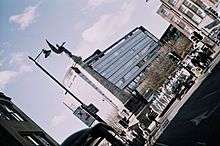Dutch angle

The Dutch angle, also known as Dutch tilt, canted angle, oblique angle or German angle, is a type of camera shot where the camera is set at an angle on its roll axis so that the shot is composed with vertical lines at an angle to the side of the frame, or so that the horizon line of the shot is not parallel with the bottom of the camera frame. This produces a viewpoint akin to tilting one's head to the side.
In cinematography, the Dutch angle is one of many cinematic techniques often used to portray psychological uneasiness or tension in the subject being filmed.
Dutch refers to German, which is called "Deutsch" in that language. It is not related to the Dutch people or language.
Method

A Dutch angle is a camera shot in which the camera has been rotated relative to the horizon or vertical lines in the shot. The primary use of such angles is to cause a sense of unease or disorientation for the viewer.[1] Many Dutch angles are static shots, but in a moving Dutch angle shot the camera can pivot, pan or track along the established diagonal axis for the shot.[2]
Notable uses
Dziga Vertov's 1929 experimental documentary Man with a Movie Camera contains uses of the Dutch angle as well, among other innovative techniques discovered by Vertov himself.
The angle was widely used to depict madness, unrest, exoticism, and disorientation in German Expressionism, hence its name Deutsch, meaning German, was often conflated with the etymologically similar word Dutch which gives the corruption of the term now commonly used. Montages of Dutch angles are structured in a way that the tilts are almost always horizontally opposite in each shot, for example, a right-tilted shot will nearly always be followed with a left-tilted shot, and so on.
The 1949 film The Third Man makes extensive use of Dutch angle shots, to emphasize the main character's alienation in a foreign environment. An anecdote of cinema lore alleges that once filming was completed, the crew presented director Carol Reed with a spirit level, to sardonically encourage him to use more traditional shooting angles.[2][3]
Dutch angles were used extensively in the 1960s Batman TV series and 1966 film, satires in which each villain had his or her own angle, as they were "Crooked".[2]
Star Trek: The Original Series would on occasion feature Dutch angles, notably in the episode "Wink of an Eye" in which the angle was used in scenes taking place in accelerated time and the transition to acceleration represented with a rotation.
The fourth season premiere of Charmed uses dutch angles in a few scenes to emphasize the imbalance felt by the main characters after Prue Halliwell's death.
Dutch angles are frequently used by film directors who have a background in the visual arts, such as Tim Burton (in Edward Scissorhands and Ed Wood), and Terry Gilliam (in Brazil, The Fisher King, 12 Monkeys, Fear and Loathing in Las Vegas and Tideland) to represent madness, disorientation, and/or drug psychosis. In his Evil Dead trilogy, Sam Raimi used Dutch angles to show that a character had become possessed.
The Dutch angle is an overt cinematographical technique that can easily be overused. The science-fiction film Battlefield Earth (2000), in particular, drew sharp criticism for its pervasive use of the Dutch angle. In the words of film critic Roger Ebert, "the director, Roger Christian, has learned from better films that directors sometimes tilt their cameras, but he has not learned why."[4]
Dutch angles are often used in horror video games, particularly those with static camera angles such as early entries in the Resident Evil and Silent Hill franchises. Similar to their use in movies, these angles are can be used to bring about a feeling of unease in the player.
See also
References
- ↑ Christopher J. Bowen, Roy Thompson (2013). Grammar of the Shot. Taylor & Francis. p. 82. ISBN 0240526015. Retrieved 26 December 2014.
- 1 2 3 Mamer, Bruce (2008). "Oblique Shot (Dutch Angle)". Film Production Technique: Creating the Accomplished Image. Belmont: Cengage Learning. pp. 9–10. ISBN 978-0-495-41116-1.
- ↑ Charles Thomas Samuels, Encountering Directors, 1972 - interview with Carol Reed, excerpt at wellesnet.com
- ↑ Ebert, Roger (2000-05-12). "Battlefield Earth". Chicago Sun-Times. Retrieved 2006-07-29.